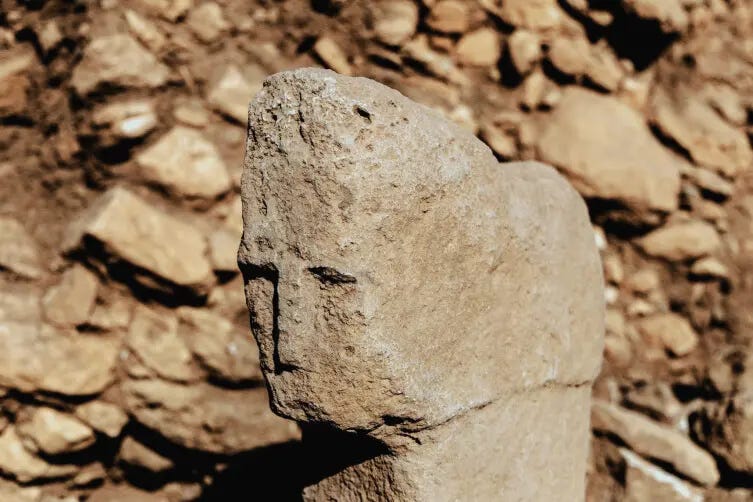🧐 Ancient Beat #169: Lost languages, psychedelic cohesion, and walking moai statues
Howdy, folks! Welcome to issue #169 of Ancient Beat. Let’s see what the world of our ancestors has in store for us today…
Here’s the latest ancient news. 👇
🗞 Ancient News: Top 5
The Lost Language Of Teotihuacan: How Two Linguists May Have Found the Voice of a Forgotten Empire — Teotihuacan, the vast metropolis that dominated central Mexico from around 100 BCE to 600 CE, has long remained one of Mesoamerica’s great enigmas. Its monumental pyramids, elaborate murals, and planned neighborhoods once housed up to 125,000 people — yet the city’s language and cultural identity disappeared with its collapse. A new linguistic analysis suggests that the painted symbols on Teotihuacan’s walls and temples may represent a genuine writing system — one that records an early ancestor of the Uto-Aztecan language family, which later gave rise to languages like Cora, Huichol, and Nahuatl. If correct, this would bridge a thousand-year gap between Teotihuacan’s fall and the rise of the Aztec Empire, revealing that the city’s people were not isolated but part of a deeper linguistic continuum that shaped Mesoamerican civilization. This discovery offers the most compelling clue yet to the voice of a society that has remained silent for over 1,400 years.
Discovery of a 12,000-Year-Old Human-Faced Standing Stone in Karahantepe — Near Göbekli Tepe in southeastern Turkey, archaeologists uncovered a T-shaped pillar carved with a human face dating to ~12,000 years ago (circa 10,000 BCE). The face shows sharp contours, deep eye sockets, and a broad nose—marking the first known instance of direct facial depictions on such monuments. Previous pillars often had stylized arms or hands; this find suggests a new level of symbolic self-representation in early Neolithic ritual architecture. Particularly interesting because I covered a human statue at Göbeklitepe last week.
Easter Island’s Statues Actually “Walked,” and Physics Backs It Up — Using 3D modeling and field experiments, scholars confirmed that Rapa Nui’s moai statues could be moved upright using rope and a side-to-side rocking motion, rather than lying flat on sledges. The statues’ design—with wide D-shaped bases and a forward lean of about 5–15°—makes them mechanically suited to such movement. A 4.35-ton replica was moved 100 m (≈ 328 ft) by 18 people in 40 minutes using the method. The ancient roads (≈ 4.5 m or ~14.8 ft wide, concave cross-section) further aided stability during transport. This supports the “walking” hypothesis that aligns with archaeological features and offers a plausible, low-material method for moving the massive figures. I believe I’m right in saying that it also aligns with the beliefs and stories of the people of Rapa Nui.
Archaeologists Uncover Ritual Platforms That Helped Pave the Way for Chinese Unification — Excavations in Shandong Province (site of Qianzhongzitou) revealed three ritual platforms dating between c. 3,000 and 2,400 years ago (Western Zhou through Warring States periods). Built from different-colored earth layers and inscribed with the character 土 (“earth”), these platforms likely served as open venues for collective rituals and feasts — as attested by cooking vessels and food remains. Such communal gatherings may have fostered shared identity among diverse communities, facilitating the cultural integration needed for later political unification of China under the Qin in 221 BCE.
The Empire in the Afterglow: How Psychedelic Beer Helped the Wari Bind a Fractured Andes — Around A.D. 800, the Wari (in south-central Peru) appear to have used a beer infused with Anadenanthera colubrina seeds (locally called vilca) during elite feasts. The brew’s “afterglow” — prolonged psychological openness and empathy — could last days or weeks, smoothing social tensions and strengthening alliances between elites and outsiders. The strategy suggests that Wari rulers didn’t rely solely on roads, bureaucracy, or military strength, but also on shared altered experience as a tool of cohesion and persuasion.
That’s it for the free Top 5! If you’re a free subscriber, sign up for the paid plan for another 25 discoveries and 4 recommended pieces of content covering teeth, genes, walls, coins, and more.
Until next time, thanks for joining me!
-James
Twitter: @jamesofthedrum
P.S. Here’s my Buy Me A Coffee link if you’d like to support my efforts with a donation.
P.P.S. If you want access to the paid version but it’s a little too steep for you right now, just email me — I want this to be accessible.
P.P.P.S. Paid members, read on!
🗞 Ancient News: Deep Dive
Keep reading with a 7-day free trial
Subscribe to Ancient Beat to keep reading this post and get 7 days of free access to the full post archives.


